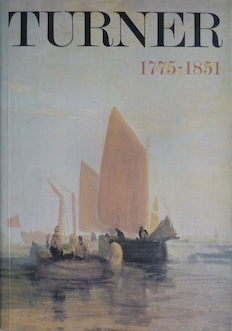|
14 XI 2024 |
4. Success at the Royal Academy 1801-12
071 - Dutch Boats in a Gale- Fishermen endeavouring to put their Fish on Board ('The Bridgewater Sea Piece') | |

| ||
|
Commissioned by the Duke of Bridgewater for 250 guineas to hang as a companion to a sea piece of 'A Rising Gale' by Willem van der Velde the Younger (repr. illustrated souvenir, Dutch Pictures 1450-1750, R.A. 1952-3, P.37). The van der Velde is, in fact, slightly smaller but Turner's composition is basically the same in reverse. There are, however, significant differences. In the van der Velde all the ships are placed diagonally to the surface of the painting, leading the eye into depth. In the Turner the distant ships are parallel to the surface and depth is suggested by the sweep of the clouds and the highly selective fall of light: the most distant ship and the far horizon are picked out in a sharp line of light and the ship in the middle distance is silhouetted against the lightest area of the sky. Turner's contrasts of light and shade are greater, but the general effect is more controlled, Neo-Classical as opposed to Baroque. Despite Thornbury's story (1877, pp.29I, 325) that Turner completely dead-coloured the large canvas the night he received the commission there are a number of sketches in the 'Calais Pier' sketchbook (T.B.LXXXI-106-9, 118-19, 126-7, 129; see No.89). The painting was unanimously well received in the press, The Porcupine classing it ‘as one of the greatest ornaments of the present Exhibition', though this praise was qualified here and in The Monthly Mirror by a desire for 'greater distinctness' in the foreground boats, a remarkably early foretaste of the perennial criticism of Turner's works. Farington's diary records the admiration of Sir George Beaumont, later to be one of Turner's fiercest critics, and Constable, and that Fuseli called it the best picture in the exhibition ‘- quite Rembrantesque’. The other oil exhibited by Turner in 1801, the lost 'Army of the Medes destroyed in the desert by a whirlwind', was less well reviewed. In 1837 Lord Francis Egerton lent a number of pictures to the summer Old Masters exhibition at the British Institution, including van der Velde's 'A Rising Gale and the painting by Turner, who thereby acquired Old Master status. This afforded Blackwood's Magazine, July-December 1837, the opportunity of comparing the two works: ‘They are both fine pictures, but painted upon very different principles. The one is careful painting, smooth in execution, very transparent... The other is with a bold and dashing pencil, with little care for anything but effect. The texture of all parts is the same, the surface is plastered; accordingly the sky, even at a considerable distance, looks rocky, and the water certainly not liquid … Still the picture is very forcible'. The Literary Gazette for 3 June came down solidly on the side of Turner: ‘we put it to the most cynical and inveterate laudator temporis acti, whether there is a single point in which the old Dutch painter has the advantage over the modern English one? Our artists ought to feel much obliged to Lord Francis Egerton ... for the opportunity thus afforded of most unequivocally shewing that, at least in one department of the fine arts, there is in this country living merit, as high as that which is attached to the greatest name, in that department, of former days'. An image generated by an AI Machine Learning Model Property of the artist. | ||
